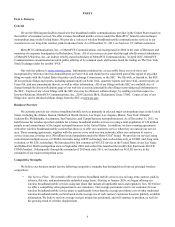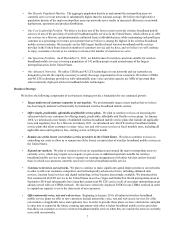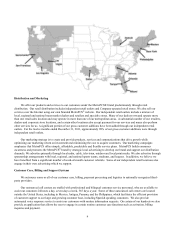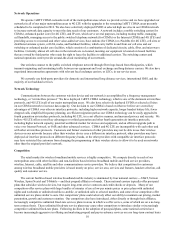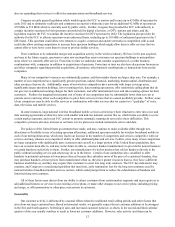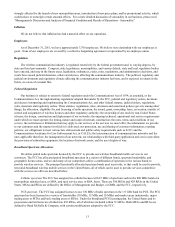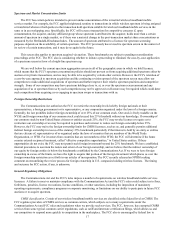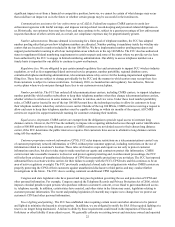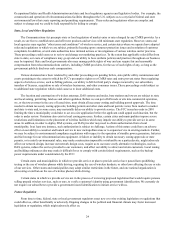Metro PCS 2011 Annual Report Download - page 25
Download and view the complete annual report
Please find page 25 of the 2011 Metro PCS annual report below. You can navigate through the pages in the report by either clicking on the pages listed below, or by using the keyword search tool below to find specific information within the annual report.14
SMR spectrum. The FCC has licensed 19 MHz of specialized mobile radio, or SMR spectrum, plus an additional 7.5
megahertz of spectrum that is available for SMR as well as other services. FCC policy permits flexible use of this spectrum,
including the provision of enhanced mobile wireless services. This includes post-800 MHz band reconfiguration spectrum.
AWS-1 spectrum. The FCC has assigned 90 MHz of spectrum to be used for AWS. The FCC divided the 90 MHz of
spectrum into two 10 MHz and one 20 MHz paired blocks assigned on a regional economic area grouping, or REAG, basis; one
10 MHz and one 20 MHz paired blocks each assigned on an economic area, or EA, basis; and a 20 MHz paired block assigned
on a Cellular Marketing Area, or CMA, basis. The CMAs generally correspond to MSAs and RSAs. Under the AWS band plan,
the United States is divided into 176 EAs, 12 REAGs, and 734 CMAs. The EAs are geographic areas defined by the Regional
Economic Analysis Division of the Bureau of Economic Analysis, U.S. Department of Commerce, as supplemented by the
FCC. REAGs are collections of EAs.
700 MHz spectrum. The FCC has allocated 72 MHz of spectrum in the 700 MHz band. The FCC divided this spectrum
into two 12 MHz paired blocks, one 6 MHz unpaired block licensed on a CMA or EA basis; one 6 MHz unpaired block
licensed on a Economic Area Grouping, or EAG, basis; one 22 MHz paired block licensed on a REAG basis, 4 MHz of
spectrum in the 700 MHz guard band. Holders of the 22 MHz licenses, most of which are held by one of our competitors, must
provide a network platform that is generally open to third-party wireless devices and applications, or an Open Network
Platform, by allowing consumers to use the handset of their choice and to download and use the applications of their choice,
subject to certain network management conditions that are intended to allow the licensee to protect the network from harm.
Congress recently passed legislation which reallocated the D Block to public safety.
BRS spectrum. In 2004, the FCC ordered that 194 MHz of spectrum in the 2496-2690 MHz band, or the 2.5 GHz band,
be reconfigured over a period of time into upper and lower-band segments for low-power operations, with a mid-band segment
for high-power operations. This spectrum is allocated and licensed in the United States and its possessions and territories in 493
BTAs. The FCC concluded in 2008 that 55.5 MHz of the broadband radio service, or BRS, spectrum holdings in the 2.5 GHz
band will be included in the FCC's product market for mobile telephony/broadband services, and taken into consideration when
the FCC is assessing the competitive impact of broadband wireless merger and acquisition transactions.
WCS spectrum. In 2010, the FCC adopted rules relating to 30 MHz of spectrum in the 2305-2320 MHz and 2345-2360
MHz bands, or the WCS spectrum, which accord licensees greater flexibility to offer, among other services, mobile broadband
services. The WCS spectrum initially was auctioned in 1997 into four license blocks. Two 5 MHz paired channels were
auctioned on a major economic area, or MEA, basis and two unpaired 5 MHz channels were auctioned on a REAG basis.
MEAs are a collection of EAs. Under the recently adopted rules, WCS licensees are subject to revised construction
requirements.
Future allocations. The FCC has certain broadband wireless spectrum allocation proceedings in process. For example, the
FCC is considering service rules for an additional 20 MHz of paired AWS spectrum, or AWS-2, in the 1915-1920 MHz,
1995-2000 MHz, 2020-2025 MHz and 2175-2180 MHz bands, as well as 20 MHz of unpaired AWS spectrum, or AWS-3, in
the 2155-2175 MHz band. The FCC also is considering whether the unpaired AWS-3 spectrum could be paired in either a
symmetrical or asymmetrical basis with other spectrum to create more paired spectrum. Both AWS-2 and AWS-3 have been
allocated for advanced fixed and mobile services, including AWS. The FCC and interested parties have proposed that these
blocks of spectrum be subject to various conditions, configurations and terms and conditions. Congress recently passed
legislation which would require the FCC to auction and license up to 65 MHz of spectrum, including AWS-3 and up to 15 MHz
of AWS-2, by early 2015. Further, Congress has provided the FCC with authority to conduct incentive auctions for both
spectrum currently held by DTV stations and others, and the legislation requires the FCC to conduct the incentive auctions for
DTV spectrum by 2022.
Backhaul. We also use paired and unpaired microwave spectrum to transport our traffic between our cell sites and our
switches and enhanced packet core facilities. This spectrum is licensed on both a point-to-point basis and on a BTA basis.
In 2010, the FCC released its National Broadband Plan, which indicates that the FCC will seek to allocate 300 to 500
MHz of additional spectrum below 2.5 GHz, over the next 5 to 10 years, for use in providing mobile wireless broadband
services. The FCC also is taking additional steps to repurpose spectrum for mobile wireless broadband use. The FCC has
initiated a series of proceedings designed to identify additional spectrum that can be refarmed, reassigned, or reallocated to
meet a perceived need for an additional significant amount of spectrum for wireless broadband mobile services. For example,
one of these proceedings is a Notice of Inquiry, or NOI, in which the FCC proposes to conduct voluntary incentive auctions for
spectrum currently used for digital broadcast television services. Congress recently passed legislation providing the FCC with
the authority to conduct incentive auctions, including auctions for digital broadcast television. The FCC also has initiated a
Notice of Proposed Rulemaking, or NPRM, and NOI regarding the regulatory flexibility of 90 MHz of mobile satellite service,




